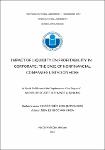| dc.description.abstract | The balance between liquidity and profitability is considered main factor contributing
the survival of a firm. In theory, analysts believed that there is a trade-off between liquidity
and profitability. If firm concentrates too much on liquidity, this will make funds become
unavailable to use; as a result, firm may miss many valuable investment and opportunity cost
will be generated. Inversely, focusing on profitability can make liquidity insufficient to cover
debts falling due. Liquidity can be view as two ways: static view or dynamic view. Static
measures of liquidity are traditional ratio such as current ratio, quick ratio and cash ratio.
Dynamic measure usually is represented by cash conversion cycle. Many ideas claimed that
liquidity should be measured by dynamic view-cash conversion cycle because it may reflex
the true liquidity.
This study is conducted to investigate how static liquidity affects profitability and
how dynamic liquidity affects profitability. The result is expected to show the difference
between two relations and firms can base on this to adjust their strategy. Independent
variables include current ratio, quick ratio and cash conversion cycle. Dependent variables
are return on equity and return on assets. Besides, study used some control variables which
are firm size, firm growth and leverage. This study covers all of nonfinancial companies
listed on HOSE over the period of five years (2011-2015). Data is collected from annually
financial statement of each firm. Next, the author will conduct descriptive statistic analysis,
correlation analysis and regression testing. Data in this study is panel data so this study must
implement some tests to choose the appropriate model.
The result shows that current ratio and quick ratio have no effect on both return on
equity and return on assets while cash conversion cycle has negative significant influences on
both return on equity and return on assets. This confirms the idea that liquidity should be
measured by cash conversion cycle when investigating impact of liquidity on profitability.
Besides, firm size and firm growth have positive significant effects on profitability. Leverage
is found out that it affects probability negatively. | en_US |


